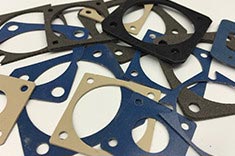EMI Shielding Products
- Custom Gasket Fabrication
- Connector Gaskets
- Bonded O Ring
- Custom Gaskets
- Conduct-O-Knit Knitted Wire Mesh
- Conduct-O-Seal Combo Gasket
- Conduct-O-Elastomer
- Conduct-O-Seal Oriented Wire in Silicone Gasket Material
- Conduct-O-Mesh Tape
- Conduct-O-Foam
- Conduct-O-Bond
- Optical Filters For Electronic Displays
- Shielded Vent Panels
- ESC Board Level Shielding
- 300 Series
Understanding the Differences Between Spliced Gaskets and Molded Gaskets
When it comes to EMI shielding gaskets, it is essential to keep in mind that there are many options for materials, shapes, and sizes. In most instances, they are constructed from a base material (fluorosilicone and silicone) that are combined with conductive fillers (silver and nickel-plated graphite). Of all products available to engineers, conductive elastomers are considered one of the most versatile products in the EMI shielding industry.

When creating these gaskets, engineers have two manufacturing options. Each option provides different outcomes, so it is vital to learn about them. Do you know the difference between molded gaskets and spliced gaskets?
In many cases, a conductive elastomer gasket is extruded into long strips that are available to buy in bulk or cut to length. To create O-rings, extrusion materials are cut and then the ends are fused. This is a process called splicing and is uses proprietary adhesives to develop incredibly strong bonds.
Splicing is popular because it offers quicker turn parts and easy modifications for design. Manufacturers like it because of the minimal tooling cost. It is vital to remember that this production method cannot process intricate designs, and it is limited to smaller sizes.
EMI RFI Shielding
Gasket mold works by compressing an uncured elastomer material into a specific mold. The material will take the shape of the mold and will retain its form once cured. Gasket molds are used for EMI shielding or RFI shielding when you are working complex parts that are economical and good for small sizes. This method does have high tooling costs associated with it.
EMI Shielding- Choosing Between Metal and Plastic EnclosuresTo protect devices, engineers commonly turn to EMI and RFI shielding. It is possible to reduce EMI through design, but in specific case, EMI cannot be reduced enough to meet various EMI-RFI standards. EMI shielding protects devices that cannot defend themselves.
- When is EMI Shielding Necessary
- EMI & RFI Protection for Medical Devices and Equipment



